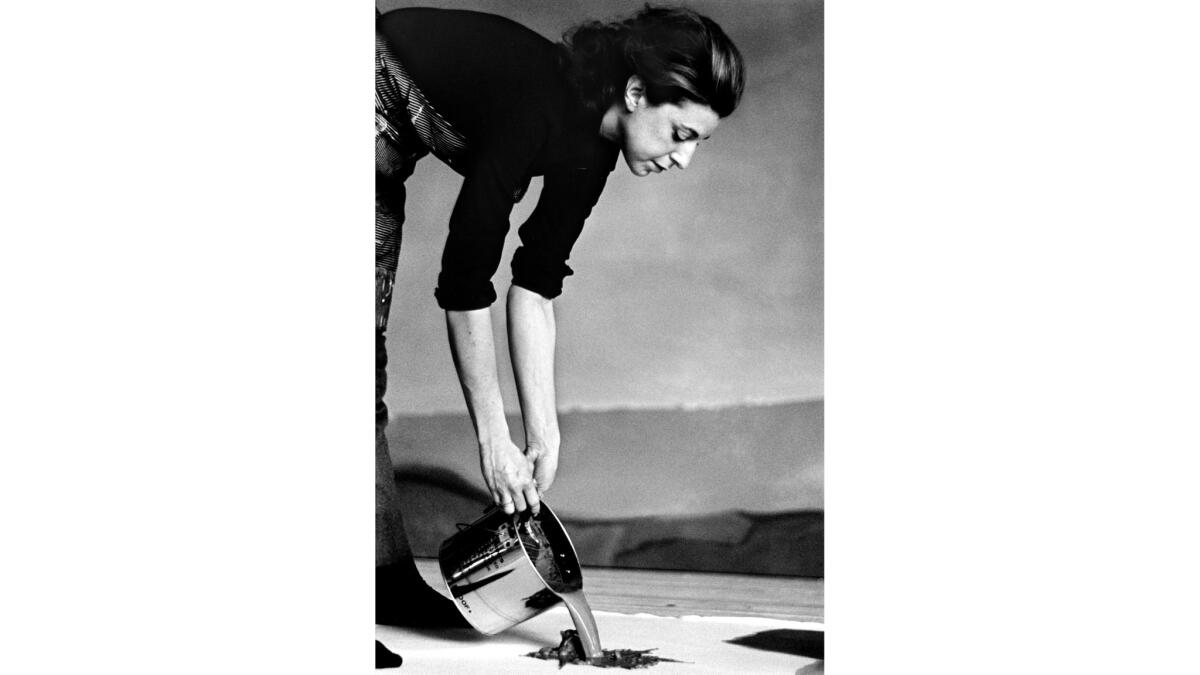It’s the D-word again. Palm Springs Art Museum mulls a major deaccession

Joining the growing — and increasingly controversial — list of American art museums that have sold or are preparing to sell major paintings from their permanent collections, the Palm Springs Art Museum is finalizing discussions to bring Helen Frankenthaler’s monumental 1979 canvas “Carousel” to market, according to multiple people with knowledge of the plan.
A museum spokesman declined to speak about the proposed sale, which is expected to be announced soon.
“Carousel” is one of a number of large works Frankenthaler completed in the late 1960s and 1970s. Spanning more than 7 feet in height and 17 feet in width, it is among 132 works of art donated to the Palm Springs museum in 1994 by the late interior designer Steve Chase. The benefactor, one of the largest in the museum’s history, also pledged $1.5 million for a gallery expansion that was subsequently named in his honor.
Sales of important art from established museum collections have now caused controversy in San Francisco, Baltimore, New York and elsewhere recently, as institutions take advantage of a vigorous art market — especially for Modern and contemporary art. Amid growing concern last spring about effects of the COVID-19 pandemic on museum finances, the Assn. of Art Museum Directors made a debatable decision to loosen its restrictions on how income from such sales can be used by charitable institutions.
Few if any art museums now selling collection works have cited pandemic-pinched finances as the reason. Many have said the move is motivated by a desire to raise funds to diversify collections through acquisition of more works by women and people of color, who are typically under-represented in art museum collections.
In June, following the police killing of George Floyd in Minneapolis, an open letter circulated on social media sharply criticizing the Palm Springs museum for failing to take remedial action on social justice issues within the institution. That makes the planned sale of a work by Frankenthaler, a prominent female artist, especially surprising.
Critics of the AAMD’s loosened sale requirements worried that a selling spree would follow, with important works of art long in the public realm disappearing into private collections. On Tuesday, the Everson Museum of Art in Syracuse, N.Y., sold Jackson Pollock’s rare and important 1946 “Red Composition” at auction for $13 million. The painting, arguably the most important one among the Everson’s holdings in American art, had been in the museum’s collection for nearly 30 years.
As part of an alarming trend, a museum is selling a 1946 Jackson Pollock drip painting to raise money to diversify its collection. Good intention, bad plan.
The Pollock sale will not be finalized until a legal challenge to the action, filed with the commissioner of the New York State Education Department, is resolved. The buyer has not been identified.
The reason for the Palm Springs sale is unclear. Museum Director Louis Grachos, in the post for just over 18 months, told the Palm Springs Desert Sun shortly after his hiring that his chief aim was to share “the thrill of growing a collection.” In 2007 Grachos ignited a firestorm when some 200 antiquities and pre-Modern works of art from the collection of Buffalo’s Albright-Knox Art Gallery, where he was director, were sent to the auction block.
Prices for paintings by female artists have historically lagged behind those of their male counterparts, but the gap is narrowing. Three monumental Frankenthaler canvases have sold at auction this year for $3 million or more — a significant jump in the established market for her works from the period. “Royal Fireworks,” a 1975 painting of comparable size to “Carousel,” fetched $7.9 million in June.
Those recent sales were all from private collections.
“Carousel,” soaked in big swaths of deep red with dark shadows and flashes of light glimpsed in between, is one of two by Frankenthaler in the desert museum’s collection; the other is a smaller 1972 canvas called “April Screen.” The museum’s website describes both as “major works in the collection” painted by “one of the great 20th century American artists.”
A second-generation Abstract Expressionist, Frankenthaler died in 2011 at 83. Advancing a key strategy pioneered by Pollock, she poured pigment directly onto canvas laid out on the floor, using sponges to stain the canvas and spread the color into abstract fields.
“Mountains and Sea” (1952), painted when she was 23 and now on extended loan to the National Gallery of Art in Washington, was her first foray into what came to be called Lyrical Abstraction or Color Field painting. The stain technique was an influence on many other artists, especially Morris Louis.
Pop artist Roy Lichtenstein took a playful jab at Frankenthaler’s distinctive and widely remarked-upon method in 1962, painting a commercially derived image of an elegant woman’s hand swiping a sponge.
More to Read
The biggest entertainment stories
Get our big stories about Hollywood, film, television, music, arts, culture and more right in your inbox as soon as they publish.
You may occasionally receive promotional content from the Los Angeles Times.











